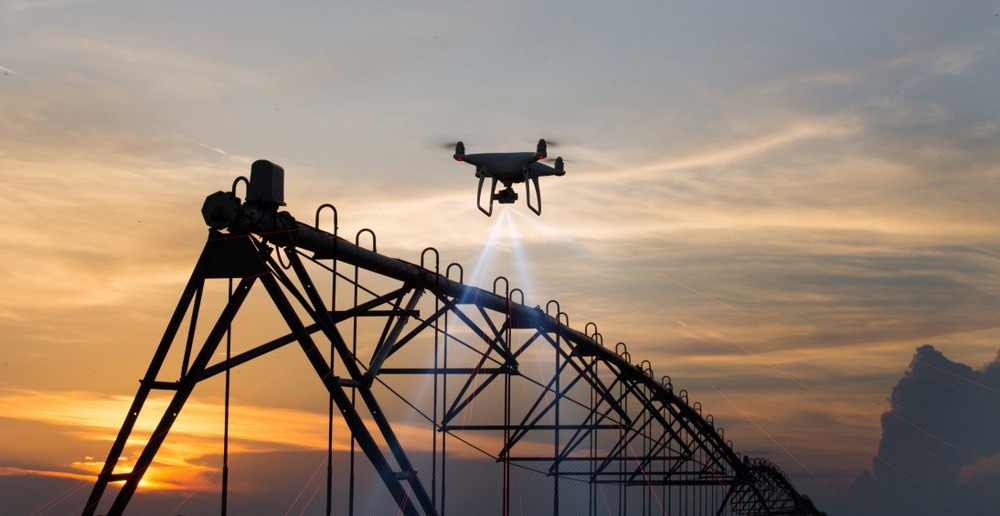 By Owais AliReviewed by Lexie CornerApr 4 2024
By Owais AliReviewed by Lexie CornerApr 4 2024Laser technology is revolutionizing agriculture, offering innovative solutions to longstanding challenges, and transforming global farming practices for greater efficiency and sustainability.

Image Credit:Budimir Jevtic/Shutterstock.com
Initially utilized in medical treatments, the application of laser technology has extended to agriculture through advancements in photobiology and photochemistry. Its affordability and effectiveness have made it a popular tool in precision farming, complementing other technologies such as drones and IoT sensors. This integration enables more efficient crop cultivation.1
Lasers: Applications and Benefits in Agriculture
Elemental Analysis of Soil
Soil is a complex mixture of organic matter, minerals, air, and water, essential for plant growth and global climate regulation. However, human activities contaminate soil with heavy metals, which plants can absorb, transferring these contaminants through the food chain and endangering ecosystems and human health. Monitoring soil composition is, therefore, vital for safeguarding environmental, agricultural, and public health.
Laser-induced breakdown spectroscopy (LIBS) has emerged as a powerful tool in this domain, enabling rapid and accurate elemental analysis of soil composition.
LIBS creates a microscopic plasma by focusing a high-energy laser pulse on the soil surface, emitting characteristic light spectra for precise elemental analysis. The spectra’s wavelength indicates the type of element present, while the intensity reflects its concentration.
This technique enables rapid, in-situ detection of nutrients, heavy metals, and contaminants, facilitating targeted soil management strategies and minimizing environmental impact.2
A study published in Science of the Total Environment used LIBS to analyze soil fertilizers for macronutrients (Mg, Ca, K, P) and micronutrients (Fe, Cu, Na, Zn Mn). The researchers compared single-pulse and double-pulse configurations and found that DPLIBS significantly improved the limit of detection values, making it a promising technique for the qualitative analysis of soil fertilizers without requiring chemical sample preparation.3
Companies like Applied Spectra and SciAps offer LIBS-based analyzers for agricultural applications, providing real-time insights into plant health and nutritional status.4,5
Laser Biostimulation
Laser biostimulation has emerged as a promising and sustainable approach to enhancing seed germination, plant growth, and stress tolerance.
When seeds or plants are exposed to specific wavelengths of laser light (for example, He-Ne at 632.8 nm, Nd:YAG at 532 nm, or LEDs in the visible spectrum), the photons are absorbed by light-absorbing molecules (chromophores) in the plant cells.
This absorbed energy triggers a series of photochemical reactions and signaling pathways, leading to increased germination rates, enhanced growth parameters (including root and shoot length and seedling mass), and improved yield characteristics.
Laser biostimulation has also been shown to augment the biochemical properties of plants, such as increasing the concentrations of proteins, antioxidants, and enzymes involved in stress defense mechanisms. These changes improve plant tolerance to drought, salinity, UV-B radiation, and diseases.6
Laser Land Leveling
Precision land leveling, enabled by laser-guided systems, achieves a remarkable accuracy of ±1 cm, essential for efficient crop management and irrigation practices.
The system includes a laser transmitter and receiver to emit and detect laser light, with the received signal containing elevation data. This data drives a hydraulic system and bucket/scraper for precise land leveling.
Research indicates that this technology can lead to 25–30 % water savings and increase crop yields by 5–30 % compared to conventional practices. It optimizes water usage, enhances weed control, expands cultivable areas, and improves fertilizer efficiency, ultimately enhancing crop productivity and profitability.6
Companies like Trimble and Topcon offer advanced laser land leveling solutions, empowering farmers with cutting-edge technology for sustainable land management.7,8
Weed Control
Conventional weed control methods, such as herbicides and tillage, have raised environmental concerns and fueled the search for sustainable alternatives. Laser technology offers a promising solution by precisely targeting and eliminating weeds through thermal or mechanical methods.
Laser-based weed control systems precisely direct high-energy laser beams onto the target weeds, causing localized heating and subsequent dehydration or tissue damage.
This highly selective approach targets only the identified weed species without harming surrounding crops. It also eliminates the need for broad-spectrum herbicide applications, reducing the environmental impact and potential for herbicide resistance development.9
A study published in Arogonomy investigated the effects of laser treatment on apical meristems of certain weed species (Brassica napus, Tripleurospermum inodorum, and Stellaria media) in their cotyledon stage. The researchers investigated different lasers, spot sizes, and energy doses on pot-grown weeds, observing significant growth reduction and, in a few cases, weed mortality.10
Emerging Trends and Innovations
Integration with Advanced Technology
Laser sensors on drones or robots enable high-resolution, wide field-of-view mapping, providing real-time data on terrain elevation, soil moisture, and crop health. This data can be analyzed by AI algorithms for informed decision-making and integrated with IoT devices for precise actions in agriculture.
Recently, Carbon Robotics' LaserWeeder was named "Best AI-based Solution for Agriculture" at the AI Breakthrough Awards. This AI-powered robot can kill up to 99 % of weeds, operate across two acres per hour, and eliminate up to 5,000 weeds per minute. It does not damage crops, and farmers utilizing it have reduced weed control costs by up to 80 %.11
Sustainability and Environmental Impact
Agriculture is a major contributor to global greenhouse gas (GHG) emissions, accounting for nearly 13.5 % of total anthropogenic emissions. Precision agriculture practices using laser-based systems offer a way to reduce chemical use, minimize environmental footprints, and support sustainable farming practices worldwide.
A study in Agronomy comparing precision land leveling (PLL) with traditional land leveling (TLL) in sugarcane fields over six years (2009 to 2015) demonstrated the benefits of PLL. The findings revealed that PLL exhibited higher energy productivity (90.7–198.6 GJ ha−1), land use efficiency (64.9–86.2 %), and lower greenhouse gas emissions (5249.33–944.19 kg CO2 eq ha−1 yr−1) compared to TLL.12
Agricultural Laser Technology: Challenges and Innovative Solutions
Despite the promising advantages, the widespread adoption of laser technology in agriculture faces significant challenges.
On the technical front, the reliability and need for regular recalibration of laser sources and sensors pose significant hurdles, as their performance can diminish over time.
Socio-economically, the acceptance of laser technologies by the agricultural community, particularly in tropical regions, may face skepticism regarding the technical and economic benefits.13
However, the integration of lasers into agriculture offers substantial benefits, including precision land farming, higher crop yields, and improved resource efficiency.
Ongoing research into new laser materials and system design can drive technological advancements, enhancing efficiency and cost-effectiveness. With supportive government policies, improved awareness, and industry innovation, the adoption of laser technologies can be accelerated, offering a new horizon of productivity and sustainability for the agricultural sector.
More from AZoOptics - Revolutionizing Infrastructure: The Future of Fiber Optic Sensing in Structural Health Monitoring
References and Further Reading
- Metwally, SA., Abou Leila, BH., Gaballah, MS. (2020). Laser application in agriculture and its physiological effect on plant: a review. Plant Arch. https://www.plantarchives.org/20-2/9535-9541%20(7175).pdf
- Yu, K., Ren, J., Zhao, Y. (2020). Principles, developments and applications of laser-induced breakdown spectroscopy in agriculture: A review. Artificial intelligence in agriculture. doi.org/10.1016/j.aiia.2020.07.001
- Nicolodelli, G., Senesi, GS., de Oliveira Perazzoli, IL., Marangoni, BS., Benites, V. D. M., Milori, DMBP. (2016). Double pulse laser induced breakdown spectroscopy: A potential tool for the analysis of contaminants and macro/micronutrients in organic mineral fertilizers. Science of the total environment. doi.org/10.1016/j.scitotenv.2016.05.153
- ASI Marketing. (2016). Direct Determination of Contaminants and Major and Minor Nutrients in Solid Fertilizers Using Laser Induced Breakdown Spectroscopy (LIBS). [Online] Applied Spectra. Available at: https://appliedspectra.com/fertilizer-analysis-using-libs.html
- SciAps. (2024). Rapid Measurement of Total Organic Carbon in Soil. [Online] SciAps. Available at: https://www.sciaps.com/industries/food-and-agricultural
- Nadimi, M., Sun, DW., Paliwal, J. (2021). Recent applications of novel laser techniques for enhancing agricultural production. Laser Physics. doi.org/10.1088/1555-6611/abebda
- Trimble. (2024). Hardware - Land forming. [Online] Trimble. Available at: https://agriculture.trimble.com/en/products/hardware/land-forming?__hstc=198439984.c4a577029c49e44b73bd3bee6fa38565.1710201600215.1710201600216.1710201600217.1&__hssc=198439984.6.1710201600218&__hsfp=892594048
- Topcon. (2024). Laser Land Leveling and GNSS Landforming. [Online] Topcon. Available at: https://mytopcon.topconpositioning.com/agriculture-smart-implements-and-harvest/scrapers/landforming
- Rakhmatulin, I., Andreasen, C. (2020). A concept of a compact and inexpensive device for controlling weeds with laser beams. Agronomy. doi.org/10.3390/agronomy10101616
- Mathiassen, SK., Bak, T., Christensen, S., Kudsk, P. (2006). The effect of laser treatment as a weed control method. Biosystems Engineering. doi.org/10.1016/j.biosystemseng.2006.08.010
- CarbonRobotics. (2023). Carbon Robotics' LaserWeeder™ Selected as "Best AI-based Solution for Agriculture" In 2023 AI Breakthrough Awards. [Online] CarbonRobotics. Available at: https://www.businesswire.com/news/home/20230621076749/en/
- Naresh, RK., Bhatt, R., Chandra, MS., Laing, AM., Gaber, A., Sayed, S., Hossain, A. (2021). Soil organic carbon and system environmental footprint in sugarcane-based cropping systems are improved by precision land leveling. Agronomy. doi.org/10.3390/agronomy11101964
- Tan, JY., Ker, PJ., Lau, KY., Hannan, MA., Tang, SGH. (2019). Applications of photonics in agriculture sector: A review. Molecules. doi.org/10.3390/molecules24102025
Disclaimer: The views expressed here are those of the author expressed in their private capacity and do not necessarily represent the views of AZoM.com Limited T/A AZoNetwork the owner and operator of this website. This disclaimer forms part of the Terms and conditions of use of this website.